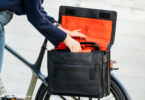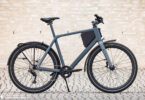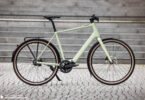Are you playing with the idea of getting an E-cargo bike or do you already own one and want to know how to use it even more efficiently in your everyday life? If so, you’re in the right place! The following tips will help you maximise the benefits of your cargo bike and make every ride a fun, safe and enjoyable experience. You’ll also find a checklist to help you keep your bike running smoothly for a long time.
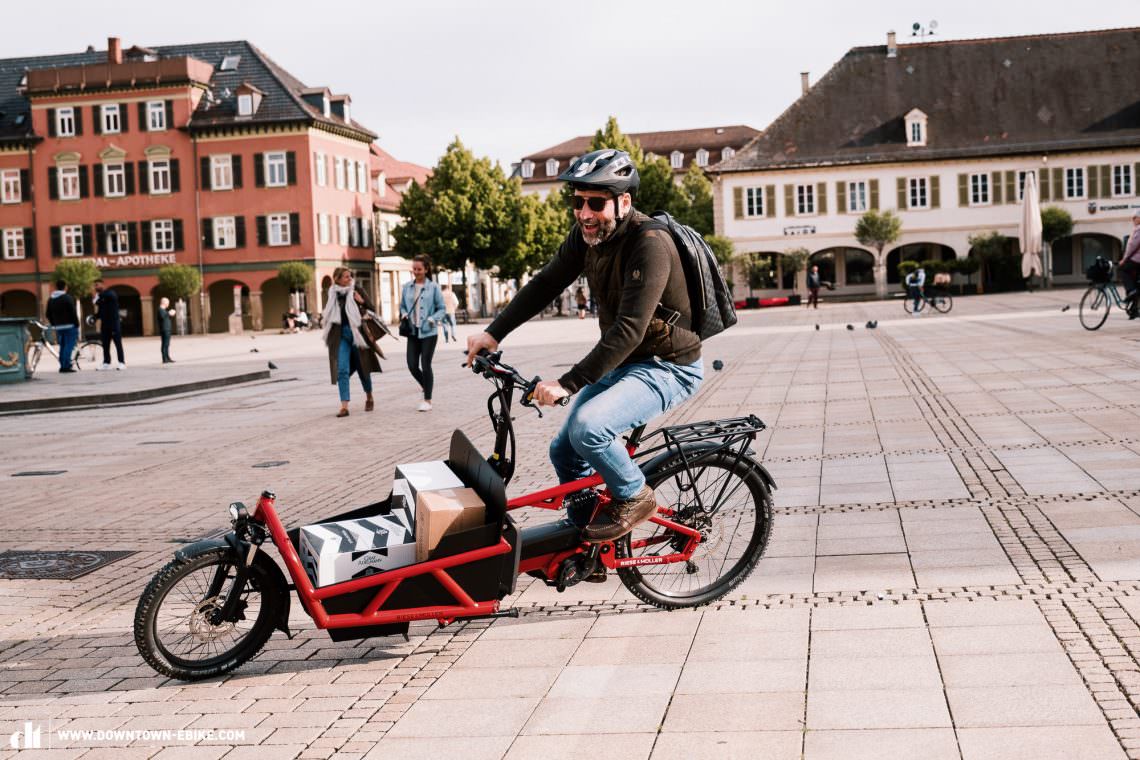
How to ride a cargo bike
Don’t worry, if you want to get a cargo bike you don’t have to learn to ride a bike from scratch. The concept is pretty straightforward: sit on the bike, ride off and quickly realise how easy and fun it is! Of course, not all cargo bikes ride the same way. A two-wheeled long john requires a different riding technique to a baker’s bike. The Riese & Müller Multicharger and Tern GSD S00 baker’s bikes require very little familiarisation, riding intuitively from the get-go. If you can ride a normal bike, you’ll be riding one of these in no time. On the other hand, the Butchers & Bicycles Mk1-E Automatic, the only three-wheeled cargo bike in our group test, is a little harder to get used to. Before you hit the road, take it to a large, empty parking lot and familiarise yourself with the new concept. Take time to get your head around the tilt system and learn how to shift your weight to steer. Our cargo bike group test will give you an overview of the different concepts available and highlight the advantages and drawbacks of each bike we tested. In an ideal world, you’ll already know which type of cargo bike suits your needs best.
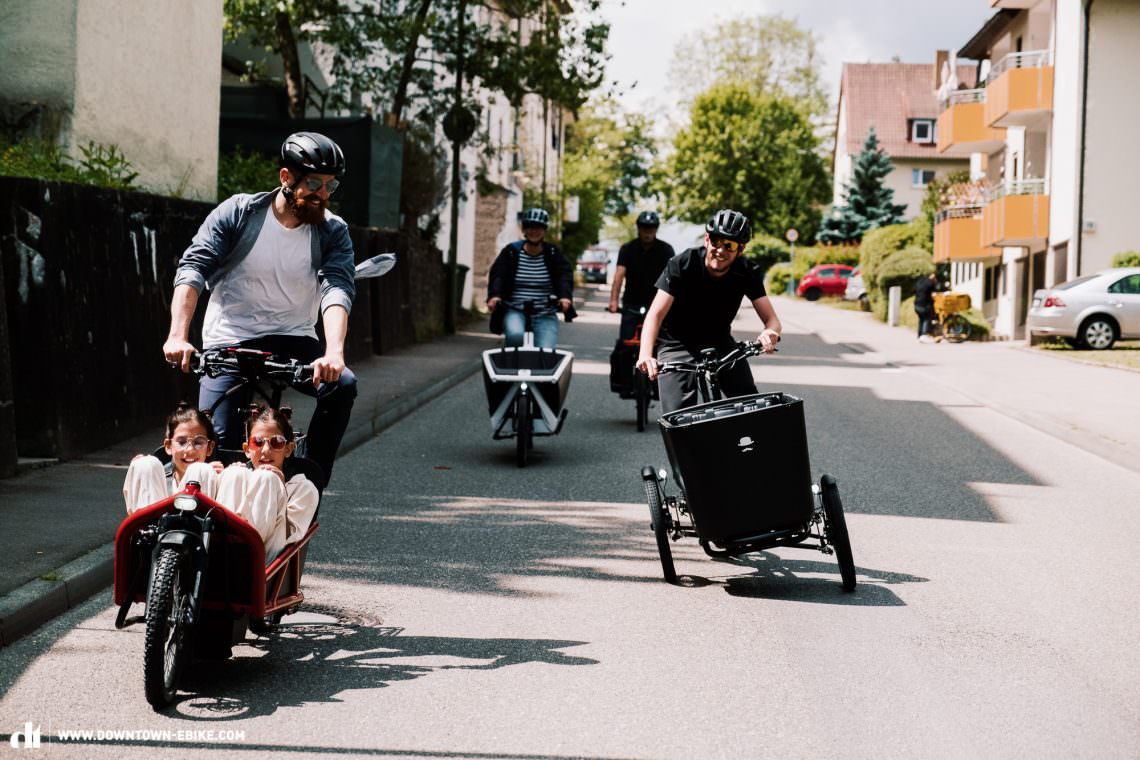
The tilt mechanism of the Butchers & Bicycles tricycle has a learning curve that takes a long time to get used to compared to Riese & Müller’s two-wheeled long john bike.
Apart from the Muli-Cycles Muli cargo bike, all bikes in this test have a motor. If you’ve never tried an ebike before, that’s one more thing you’ll have to get used to. The Bosch Cargo Line motor of the Riese & Müller Load 60 Touring E-cargo bike churns out lots of power, especially when riding in the highest support mode. If you’re new to ebikes, spend some time familiarising with the different support modes, starting from the lowest one and gradually working your way up to the strongest mode. In other words, get to know your bike and its motor before you step on the gas! Once you’re in control, nothing can stop you and let’s be honest: the real fun starts when you know what you’re doing, can ride fast and carve your cargo bike through corners with confidence. But even then you’ll have to remember that a 2.50 m long john has a larger turning circle than a normal ebike and that most road users aren’t yet used to them. Except for the compact Muli, long johns will require you to take corners wider and calculate your turning angle carefully. You should also allow for a longer braking distance. At full load, a cargo bike can easily reach 200 kg and thus inevitably takes longer to stop!
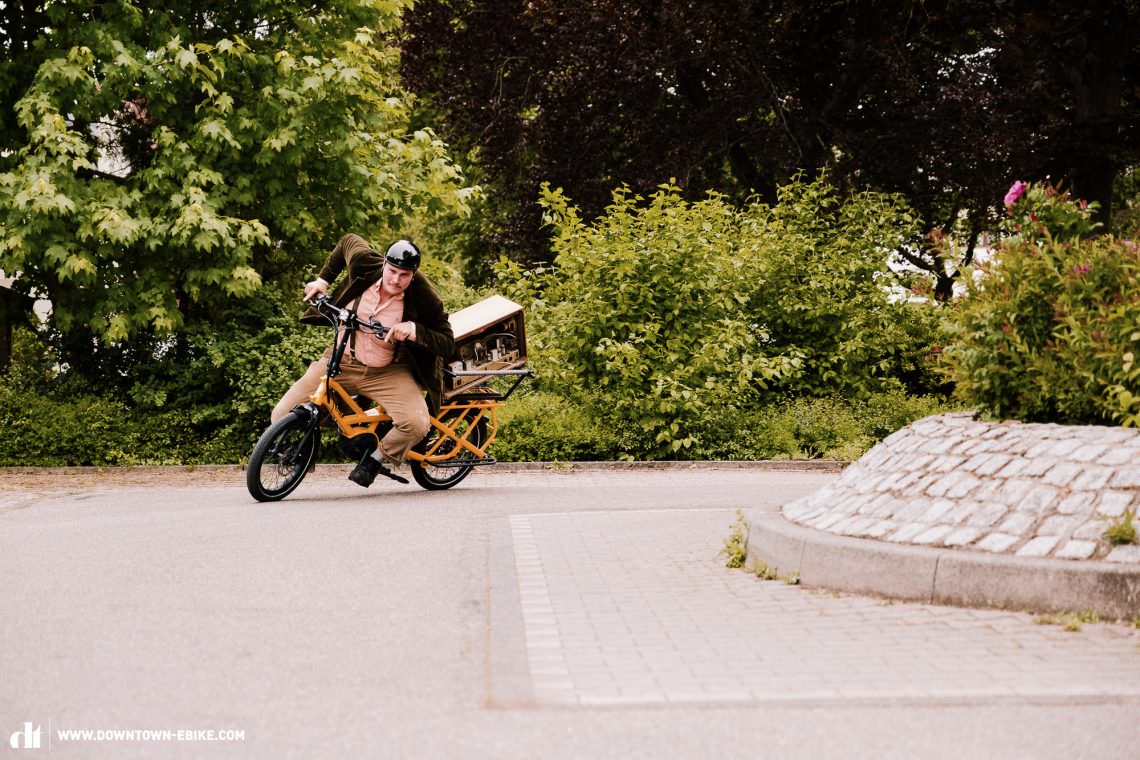
If you’re unfamiliar with ebikes, you shouldn’t underestimate the acceleration and speed of an E-cargo bike. However, once you’ve experienced the adrenaline rush of speed, there’s no way back and you’ll be left with a massive grin on your face!
When carrying a live load, you should always be ready to compensate for unexpected movements. Imagine you’re carrying your kids and they both suddenly lean out of the cargo bay to pet a cute puppy that’s standing on the sidewalk. The weight suddenly shifts to one side, dragging you, the bike and your kids to the floor. This is just one example of the many riding situations that require caution. Riding with no hands is tricky as it is and something only expert riders should do. That being said, riding a cargo bike with no hands and a couple of kids in the front is an absolute no-go. With three-wheel cargo bikes, you should avoid riding over bumps with just one front wheel. Sudden, jerky movements could shift the weight to one side and cause the bike to tip over. However, you’d have to be extremely clumsy for this to happen.
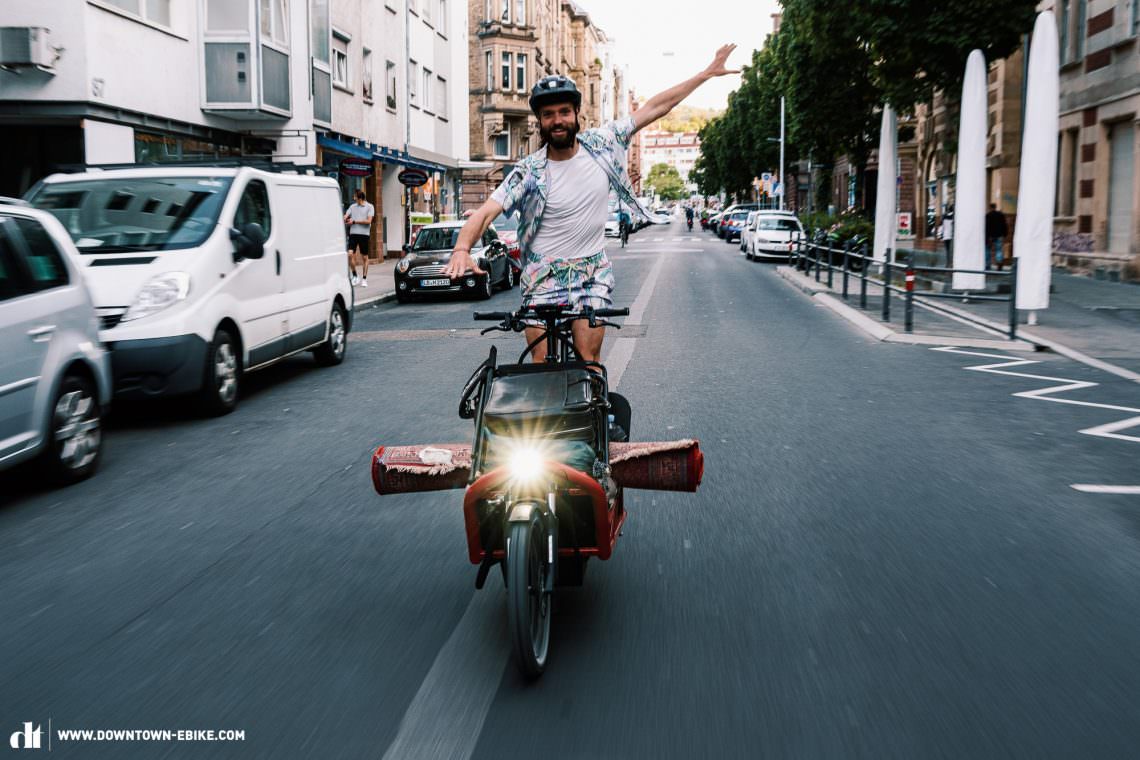
Yes, riding hands-free is possible and no, it’s not easy. It’s probably better if we don’t show you the pictures of our failed attempts…
What’s the correct way to load a cargo bike?
You go to the supermarket, take a Shopping basket and fill it with all the ingredients you need to make a cake. Eggs and salt, butter and lard… or something like that. Now, anyone in their right mind wouldn’t put the flour, milk and butter on one side and the eggs on the other – the basket would tip over immediately. The same logic applies to cargo bikes. Uneven weight distribution will cause your cargo bike to feel unsteady and the steering to pull to one side. As a result, you’ll find it harder to control your bike and ride in a straight line. That’s why you should always distribute your cargo as evenly as possible and make sure to secure it so it stays in place. While a stack of soil bags or a bundle of timber joists might look solid when you load them at the DIY shop, or even when riding home at a slow pace, a sudden braking manoeuvre or harsh change of direction could send the entire load flying across the street. A stack of timber shifting out of place will inevitably distract you, with potentially serious consequences for you and other road users. You should also make sure your cargo doesn’t obstruct your view. All bikes in this test, except for the Tern GSD S00 and Riese & Müller Multicharger GT Vario, place the load in front of the rider, which is safer for both you and other road users. As always, common sense is key – after all you wouldn’t put a heavy cement bag on the hood of your car. With cargo trikes like the Butchers & Bicycles, you should never place the load in front of the front axle. This shifts the centre of gravity and due to the bike’s design, could potentially lead to it tipping forward. Like a sports car or mountain bike, you want to maintain a low centre of gravity. The lower the load sits, the better the centre of gravity, which, in turn, has a positive effect on the handling. Bikes without suspension can feel quite harsh, so be careful with your eggs!
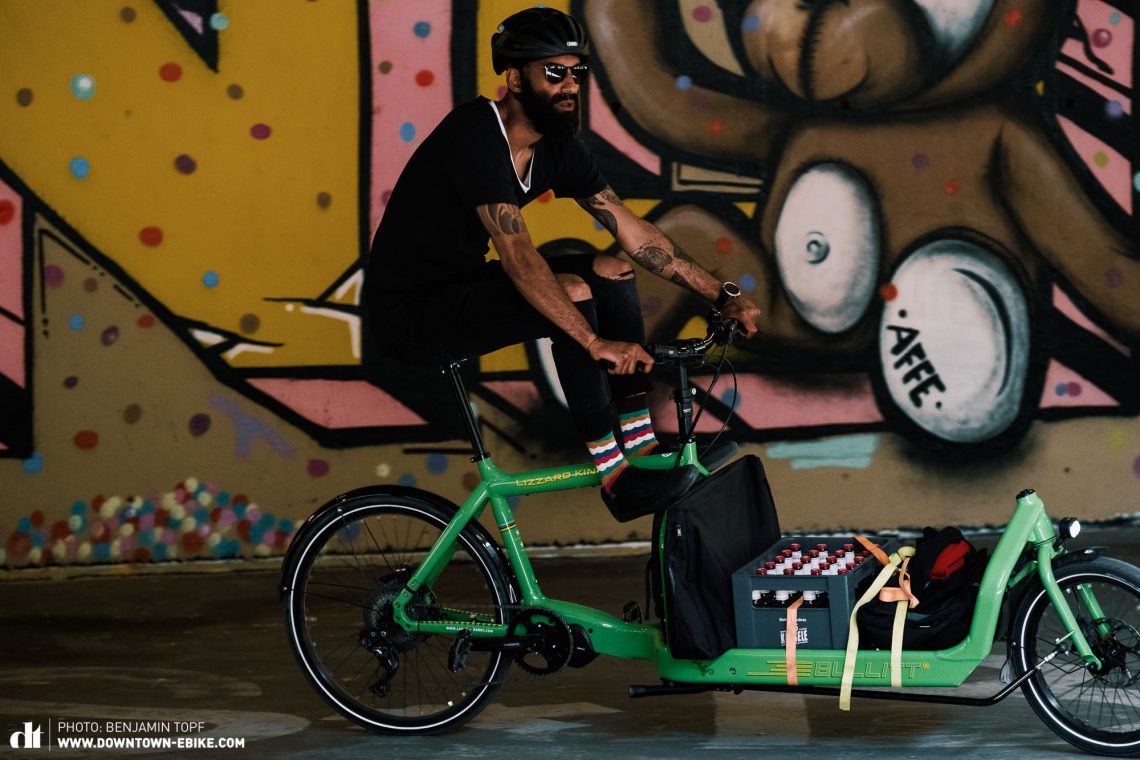
Spreading the load evenly is just as important as securing it properly. Here, a couple of straps come in handy and could prevent your night out from shattering into a million pieces.
Who can you carry on a cargo bike?
You had dinner with your best mate at your favorite restaurant in town and you spontaneously decide to hit the pub for a few pints before heading home. Public transport sucks and a normal bike doesn’t fit in a cab. Good job you took the cargo bike! In Germany, laws now govern who you can carry on your E-cargo bike. You’ll have to check your local regulations to find out what rules apply to you. It goes without saying that whether you’re carrying people or transporting loads, you always have to stay below the total permissible weight for the bike.
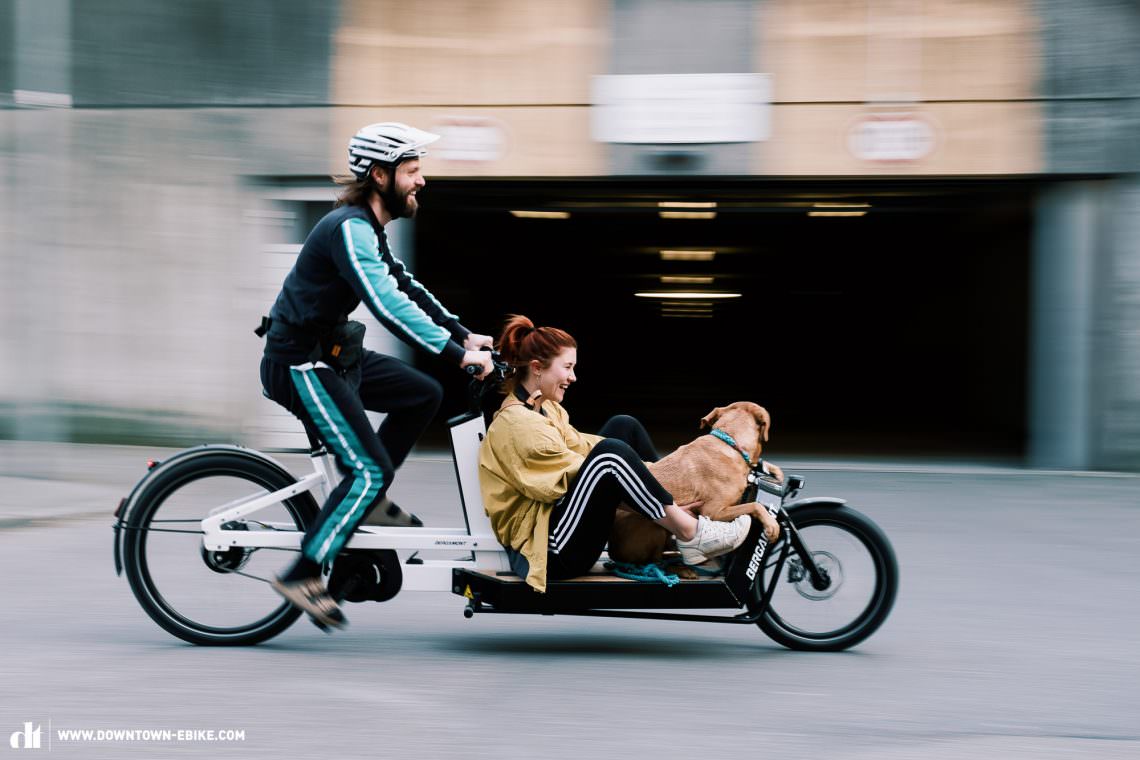
What we used to do with expensive sports cars, we now do with cargo bikes. And it’s even more fun 😉
What’s the safest way to transport children on a cargo bike
Cargo bikes are more popular than ever, especially with young families, and it doesn’t really matter whether you get one as an addition or alternative to your car. However, it’s crucial that you carry your kids just as safely and comfortably – for the biggest bike freaks among us, directly from the maternity ward to your home. While this example might sound a little extreme, cargo bikes are far more reliable and safer than normal bikes when it comes to transporting children. While conventional bikes allow you to carry kids up to an age of approximately seven years, with a cargo bike you can shuttle your offspring around town as long as there’s enough room in the box and, of course, as long as you don’t exceed the total permissible weight – perhaps you can even take your work colleague down to the pub after work! Physically, they might be considered adults, but mentally? ;). With bike trailers and cars, where the kids sit behind you, it’s much harder to keep an eye on your little rascals but with a cargo bike they’re sitting right in front of you and you can always check on them.
For families with very small children, the Urban Arrow Family could be the perfect choice. It comes with an integrated Maxi-Cosi child seat adapter and thus provides a high level of safety and riding comfort. The family-friendly cargo bike is equipped for spontaneous outdoor adventures with your kids and their friends and allows you to carry up to three, albeit rather small, passengers in the large cargo box. And if the kids get restless, a yummy snack will keep them quiet for another 10 km and you can carry on cruising peacefully. One more thing: always check the weather forecast and pack a rain jacket if needed. Just like any other cargo, always make sure the kids are properly secured and buckled up. Whether it’s a three- or five-point harness doesn’t matter, both options are safe and reliable. If you treat your kids like a set of fine china, you should look for a full-suspension cargo bike like the Riese & Müller Load 60 – more comfort is impossible.

Random tantrums can be fixed with a chunk of pretzel or, for Duplo connoisseurs, a green building block. Just like cars, seatbelts are compulsory.
Where can you ride your cargo bike?
Your partner turns 40 next week and you’re still looking for a suitable present. In your local classifieds you find the vintage hi-fi speakers (s)he’s been going on about for the past two months. Now you just have to cross town to pick them up. Are you gonna take the car and brave the rush hour traffic? No, thanks. Or maybe just get the bus? No, the speakers are too bulky to take on public transport. Oh, I know, just jump on the cargo bike and off you go! This, however, raises a few questions. Can you ride your new E-cargo bike on the same routes as your normal bike and can you still use the route planner in bicycle mode? It’s the same answer for both questions: yes! In Germany, cargo bikes have the same legal status as conventional push bikes, provided they don’t exceed a width of 1 m (2 m for two-lane cargo bikes), a height of 2.50 m and length of 4 m. If we’re talking specifically about E-cargo bikes, the nominal motor power may not exceed 250 W or provide support above 25 km / h. S-pedelecs (providing assistance up to a speed of 45 km / h) are legally classified as mopeds, so you’re allowed to ride on normal roads but not on fire roads, forest paths or bike paths. One-way streets, bus lanes and sidewalks can be included on the route as long as these are open to conventional push bikes. Stationary cars can be overtaken to the right, provided there’s enough room. On a narrow Muli bike with a folded basket, you can weave your way through the traffic like with a normal bike. Unless explicitly approved for bikes, pedestrian areas are a no-go zone both for conventional and cargo bikes!
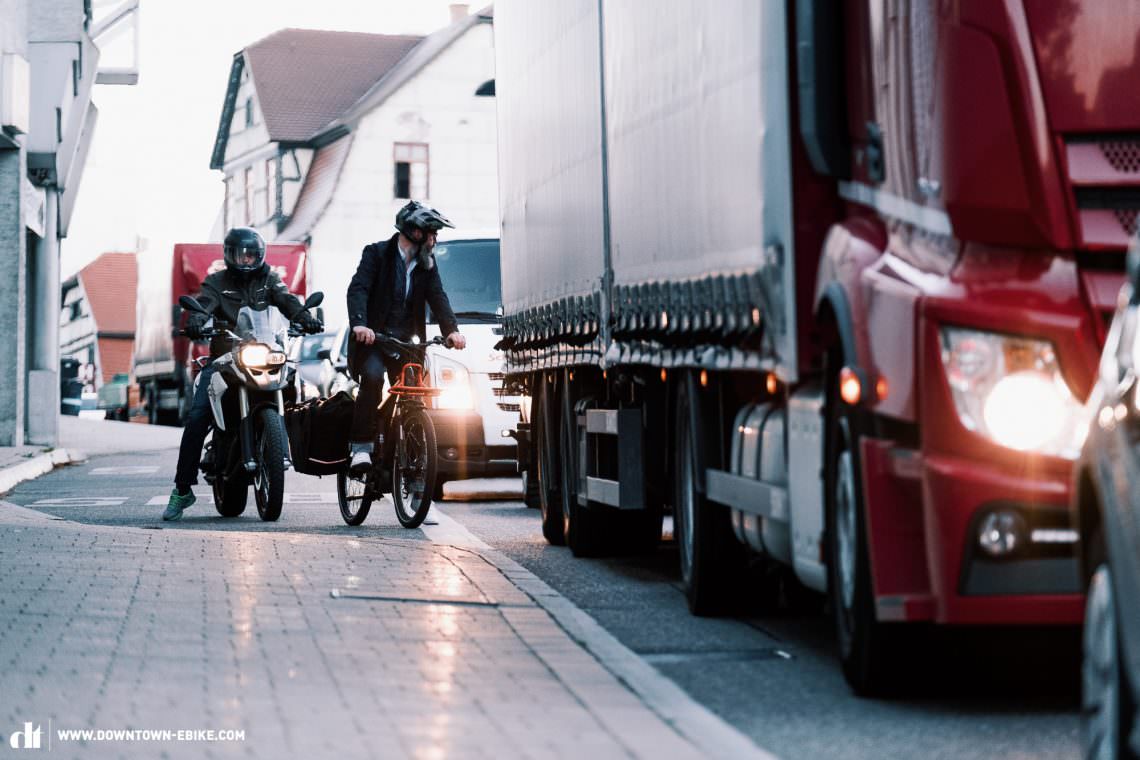
Baker’s bikes like the Riese & Müller Multicharger offer intuitive handling and fit into the narrow gaps between stationary cars and trucks
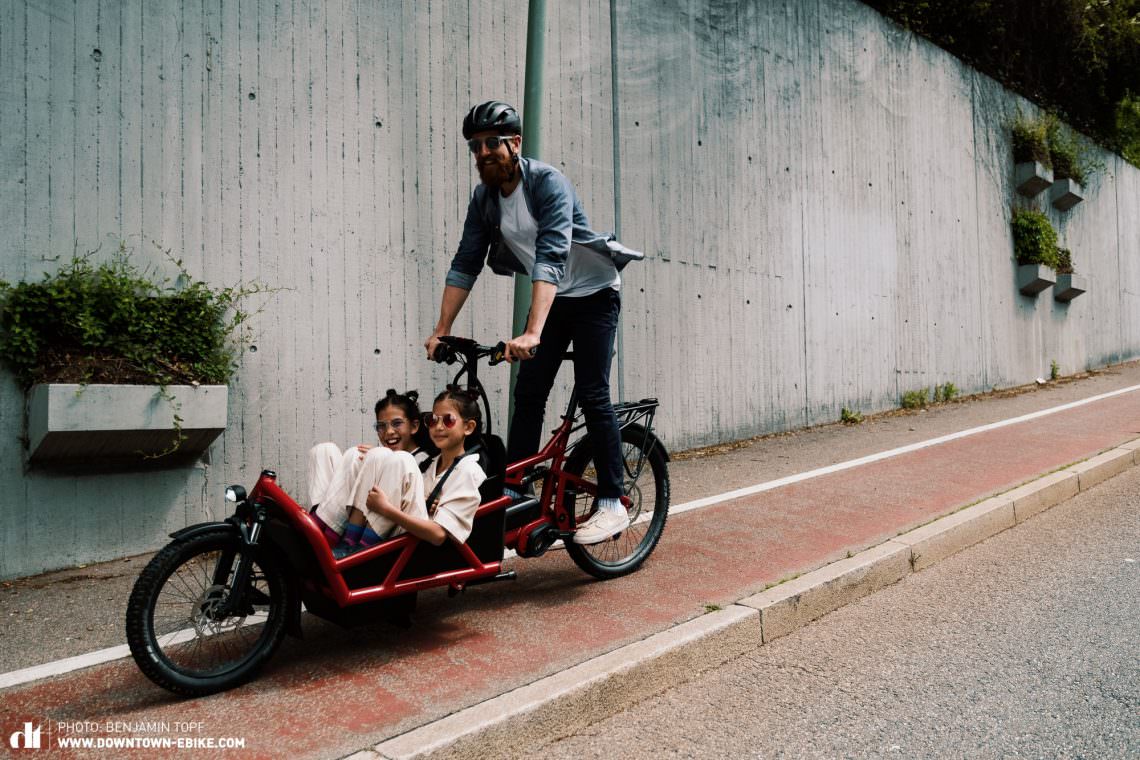
When possible, you should always use a cycle path, even with a bulky cargo bike. One-way streets, bus lanes and sidewalks cleared for bicycles can also be used with a cargo bike.
How do you (safely) ride a cargo bike in the city?
Cargo bikes have become an integral part of modern cityscapes and are gaining in popularity. Whether you’re using them commercially to deliver goods and parcels or privately to do your shopping and take the kids to school, cargo bikes suit a wide and diverse spectrum of applications in urban environments and have already sent many cars into retirement. And that’s despite their bulky appearance. But how can you get to your destination quickly and safely, in busy areas where space and consideration are scarce? If you ask us, it’s actually pretty straightforward! In the urban jungle, a full-blown cargo bike takes up significantly more room than a normal bike and is thus more likely to be noticed by other road users. Moreover, the bulky dimensions of cargo bikes seem to put car, bus and lorry drivers into a different mindset, as they identify them as more ‘familiar’ vehicles. As a result, they’ll be more likely to change lanes to overtake you, leaving plenty of room instead of rushing past you by a fraction of an inch. A very pleasant experience we could all get used to!
Of course, there are also situations that can pose challenges for cargo riders. At 2.70 m, a long john cargo bike like the Bergamont E-CARGOVILLE LJ 70 is harder to ride through crowds and along busy cycle paths. Here, shorter, baker’s bikes like the Tern GSD S00 have great advantages. Crossing dual carriageways with a central reservation can be more problematic than with a conventional bike and you should always make sure you cross both roads with a green traffic light. Speaking of traffic lights, sometimes you’ll have to request the green light by pressing a button – the front wheel of a long john could end up sticking out into the road, so pay attention.
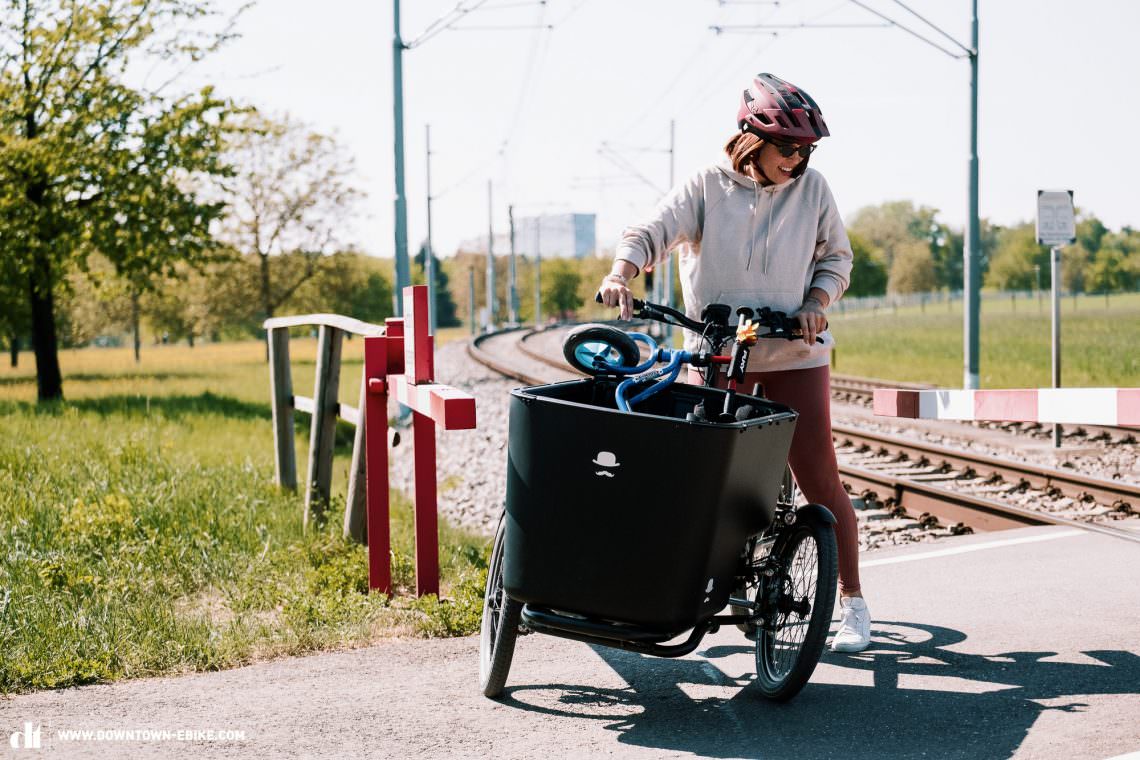
Bike path barriers and chicanes aren’t exactly cargo-friendly. However, with a little practice, you’ll get the hang of it and learn how to pass them without breaking a sweat. Here, the Butchers & Bicycles tilt concept works best.
Together with restricted spaces, stairs are the biggest natural enemy of cargo bikes. At full load, even a few steps could interrupt your journey and force you around the block or to choose an alternative route altogether. However, a fully loaded ebike with panniers is likely to give you the same problems. If you can’t find a better alternative, just ask passers-by to help you. People are much nicer than you think! Planning your route in advance is perhaps the best way to avoid unpleasant surprises along the way. When it comes to navigation, the SmartphoneHub from Bosch is king. Simply plug your smartphone in to navigate with and even charge it while riding. As a cheap and universal alternative, you could attach a conventional smartphone holder to the handlebar. Bosch’s Intuvia or Kiox displays also allow you to charge your smartphone while riding. When planning a route or navigating with Google Maps or Komoot, you should keep in mind that bike paths aren’t always suitable for cargo bikes. Sometimes the path is too narrow or the bollards set up too closely for a wide cargo bike to squeeze through. Depending on the type and design, bike lane barriers and chicanes can be difficult to pass and sometimes the only way to get through them is to get off the bike and roll it through. Other than that, cargo bikes can be used just like conventional ones and are just as versatile (or even more so) when used with common sense and a bit of forward planning. After a few trips, you’ll get used to the new proportions and enjoy the luxury and advantages of your cargo bike!
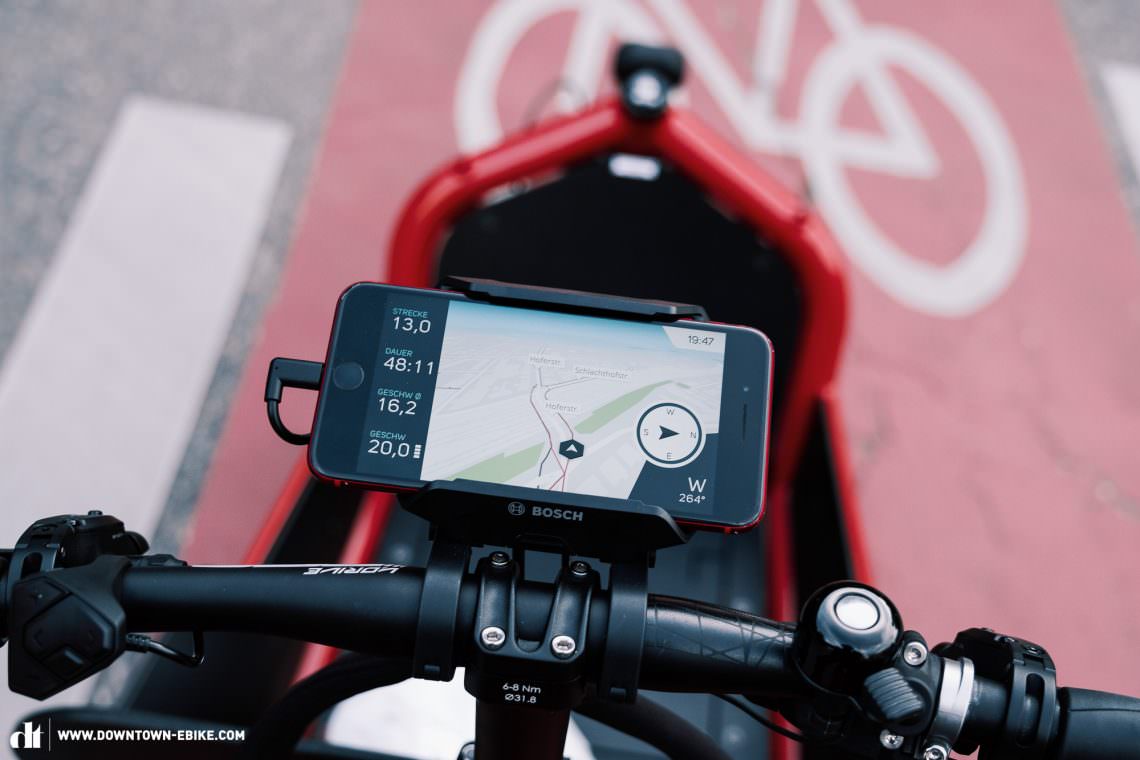
The Bosch SmartphoneHub as a multimedia center. The system provides navigation, riding data and music and even lets you control the motor. Of course, it will also charge your phone while riding!
You should also stay in the right gear while because this affects the efficiency and overall performance, both of the motor and person riding. At the same time, correct and well timed gear shifts prevent the components from wearing out prematurely. Our advice: if possible, only change one gear at a time and take the pressure off the pedals while shifting – your drivetrain will be grateful! While the Rohloff SPEEDHUB E14 does this automatically, Enviolo hub gears and derailleur systems will last a lot longer if you follow our advice.
Where do you park your cargo bike?
Open the front door, take the stairs and carry your bike into the basement – it’s not that easy with a cargo bike. Garages, storage rooms and bike sheds are the perfect places to store your cargo bike. They’re safe, dry and sometimes they even have a plug to charge your batteries. Otherwise, you can also keep it in your backyard or garden and if you live in a safe area, even on the street. However, we recommend using a tarpaulin to protect it from the elements. If you want to store your cargo bike inside your house or flat, we recommend a model like the Muli, which can be carried for a few meters without getting a hernia. Ultimately, no one knows your neighbourhood like you do! Before buying, consider whether it’s safe to leave an expensive cargo bike on the street overnight. Usually, if you feel comfortable leaving your car or scooter outside your house, you should be safe leaving your cargo bike too. Just make sure you secure it with a good lock and always attach it to a solid and well-anchored object. Tip: you can also use a (retrofittable) GPS tracker for extra peace of mind.
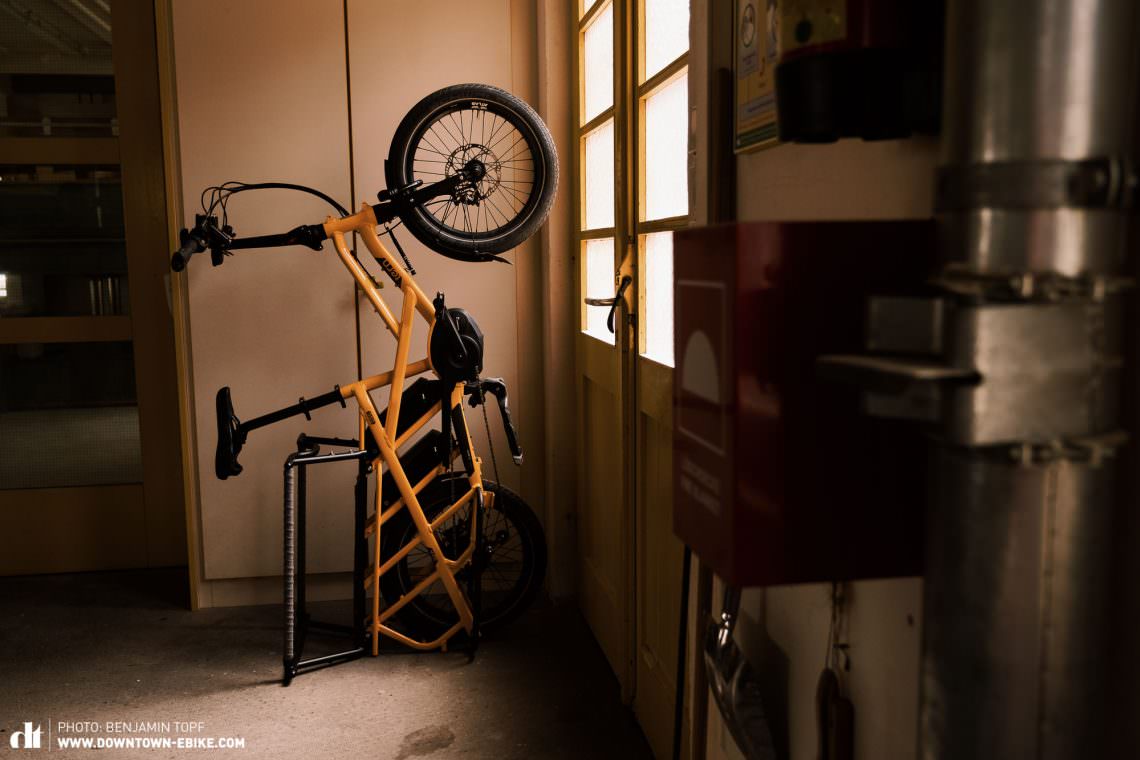
Are you sure it will fit? That’s a question the Tern GSD S00 answers with one word: yes! Vertically, the bike takes up very little space and can be squeezed into almost every corner.
Unlike cars, cargo bikes can be parked almost anywhere in town. No more stressful, time-consuming laps around the block in search of a free parking space – now you can park your cargo bike just like a normal bike, tucked away on the edge of the sidewalk without obstructing the way. In Germany, you’re also allowed to park on the kerbside, provided your bike is lit in the dark at night. Alternatively, you can also use a pay and display parking space if you pay the fee. By the way, three to four cargo bikes fit into a normal parking space! In addition, more and more big cities are creating specific parking infrastructure for cargo bikes.
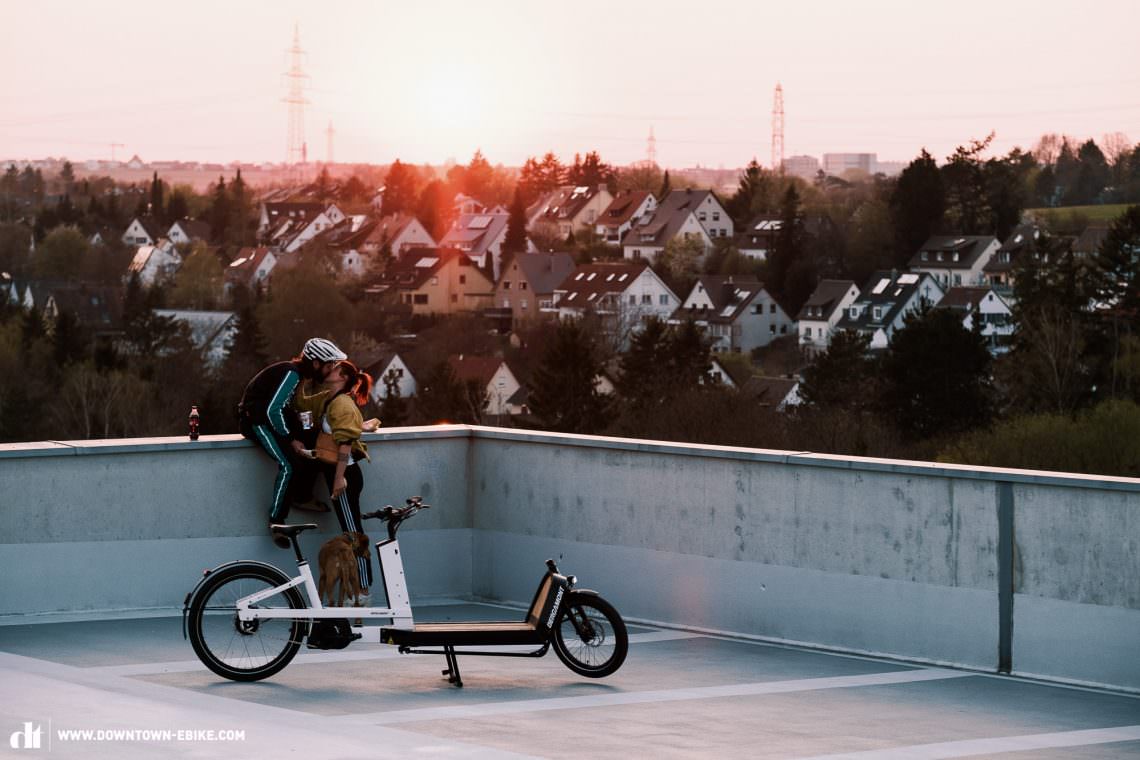
Unfortunately not! If you want to park your cargo bike on pay and display spots, you’ll have to pay the fee. As an alternative, you can leave it on the edge of the sidewalk or kerbside, provided that it’s not obstructing the way.
How do you secure your cargo bike?
An E-cargo bike can easily set you back € 5,000 – a nice lump of money! How can you protect your precious new family member against crooks? As with conventional push bikes, you should observe the following two rules: always lock your bike with the frame (not just the wheels) to an anchored object, trying to choose a busy, well-lit location, ideally with security cameras too. It should go without saying that a € 10 cable lock won’t last 2 minutes. But what about my cargo? You get off the bike, jump into the bakery to grab a roll and when you come out all your stuff is gone. The Bullitt and eBullitt cargo bikes offer an optional lockable cargo box, which deters (and prevents) thieves from stealing your goods. If you’re riding an ebike, you’ll also want to remove the batteries and display, both to prevent them from being stolen and to make sure they’re charged. Various manufacturers offer built-in GPS trackers – one of the best is Riese & Müller’s RX Connect system. If the worst comes to the worst and your bike has vanished, the manufacturer can track its location.
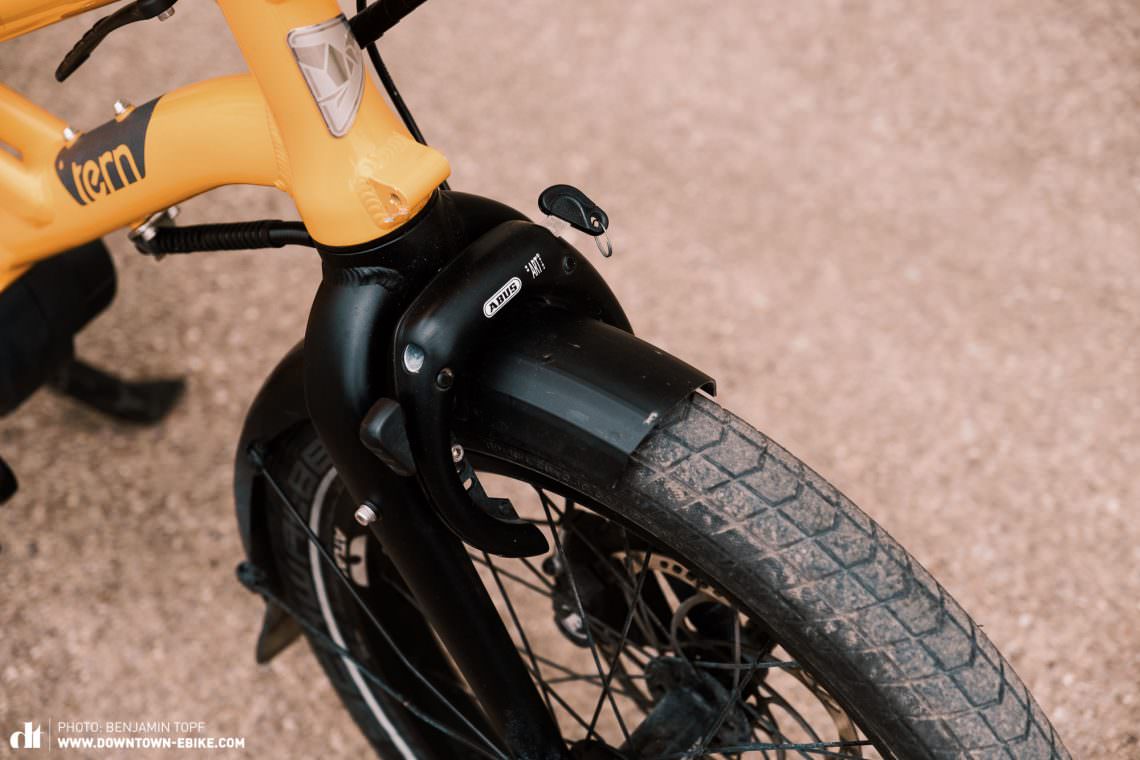
Expensive cargo bikes should be chained to a firmly anchored object using good quality locks.
How do you service and maintain your cargo bike?
If you want to have a reliable, well functioning cargo bike at all times, you have to take care of it and service it at regular intervals. Just like with conventional bikes, the basic maintenance of a cargo bike is easily manageable. Just follow a few simple steps and you’ll be able to enjoy your bike for many years to come! The most safety-relevant point: the brake pads. With most braking systems, you can see the state of your pads through the long opening on the top of the calliper. You should change the pads when the braking material has worn down to about 1 mm thick. You’ll find the right brake pads in any bike store and can either change them yourself or ask the shop to take care of it – either way, it will take less than five minutes. You should never wear down the pads completely, as the exposed metal backing plate will damage the rotor and leave you without any braking power. With a 200 kg cargo bike, this could have serious consequences. That’s why a reliable and well maintained brake system should be one of your top priorities!
Less relevant to safety, but crucial to the overall performance of the bike, is the chain. To avoid unpleasant (and costly) surprises, check your chain and drivetrain on a regular basis and replace them if necessary. Of course, this isn’t relevant if your bike runs on a belt drive. You can read more about how to take care of your drivetrain here. Unfortunately, this process is a lot more difficult with heavy cargo bikes, as you can’t just lift and hang them onto a work stand like a normal bike and with ebikes you can’t just spin your cranks backwards to lube the chain. We also recommend inspecting all screws and bolts from time to time. Is the stem still clamping the handlebars and steerer tube securely? However, make sure you stick to the manufacturer’s torque recommendation for all bolts, which are often etched directly onto the stem. Tight, tighter, snap! 😉 From time to time, it’s also a good idea to check the brake rotor bolts and your axles. Experienced riders should also check the headset is tight and the bearings are running smoothly. Place your thumb and index finger on the gap between the headtube and fork, pull the front brake and wiggle the bike back and forth. If you feel any play, either your headset needs tightening or your bearings are shot. To find out, loosen the stem, tighten the screw in the headset cap and check if the play’s gone. If it is, tighten the stem bolts back up, otherwise you’ll have to replace your bearings.
If you own an E-cargo bike, make sure you check the battery before and after each ride – you’ll avoid some very unpleasant surprises! With heavy cargo bikes, there’s nothing more irritating than getting stuck in the middle of the road with an empty battery – you’ll remember that walk of shame for the rest of your life! Always check the tire pressure before leaving and clean your fork and shock from time to time if the bike has suspension. If you follow these simple but very important rules, you’ll enjoy your cargo bike for a long time!
Our conclusion on cargo cycling
You see, everything is possible. Like all things in life, cargo bikes need good care and some time to get used to. However, you don’t need Danny MacAskill’s skills or an HGV license to ride a cargo bike – we promise! Most of them are just as intuitive to ride as conventional bikes and in most cases, it will take just a few minutes to get used to the new concept. Just try it, test it and ride around a big, empty parking lot before you hit the road – you’ll be surprised how easy and fun it is! Before you buy your new cargo bike, make sure you know where to store it safely. But don’t hold out too long! With their growing popularity, the stock of cargo bikes at your local dealer could be poorer than the emissions specifications of some car manufacturers.
Words: Philipp Schwab Photos: Benjamin Topf, Robin Schmitt, Valentin Rühl


